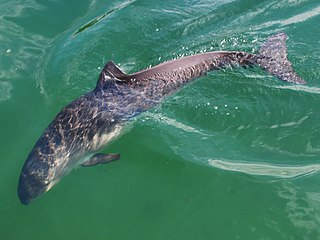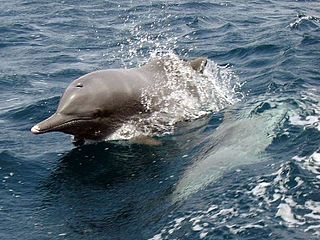Related Research Articles

Porpoises are small dolphin-like cetaceans classified under the family Phocoenidae. Although similar in appearance to dolphins, they are more closely related to narwhals and belugas than to the true dolphins. There are eight extant species of porpoise, all among the smallest of the toothed whales. Porpoises are distinguished from dolphins by their flattened, spade-shaped teeth distinct from the conical teeth of dolphins, and lack of a pronounced beak, although some dolphins also lack a pronounced beak. Porpoises, and other cetaceans, belong to the clade Cetartiodactyla with even-toed ungulates.

The Indo-Pacific finless porpoise is one of eight porpoise species. The species ranges throughout most of the Indian Ocean, as well as the tropical and subtropical Pacific from Indonesia north to the Taiwan Strait. Overlapping with this species in the Taiwan Strait and replacing it northwards is the East Asian finless porpoise.

Neophocaena is a genus of porpoise native to the Indian and Pacific oceans, as well as the freshwater habitats of the Yangtze River basin in China. They are commonly known as finless porpoises. Genetic studies indicate that Neophocaena is the most basal living member of the porpoise family.

The Indian Ocean humpback dolphin is a member of the Delphinidae family occupying coastal areas ranging from Southern Africa to Western Indochina. The Indo-Pacific humpback dolphin was formerly included within the same species, but a 2014 study revealed them to be a separate species.

Whale barnacles are species of acorn barnacle that belong to the family Coronulidae. They typically attach to baleen whales, and sometimes settle on toothed whales. The whale barnacles diverged from the turtle barnacles about three million years ago.

The baiji is a possibly extinct species of freshwater dolphin native to the Yangtze river system in China. It is thought to be the first dolphin species driven to extinction due to the impact of humans. This dolphin is listed as “critically endangered: possibly extinct” by the IUCN, has not been seen in 40 years, and several surveys of the Yangtze have failed to find it. In China, the species is also called the Chinese river dolphin, Han river dolphin, Yangtze dolphin and whitefin dolphin. Nicknamed the "Goddess of the Yangtze", it was regarded as the goddess of protection by local fishermen and boatmen. It is not to be confused with the Chinese white dolphin or the finless porpoise. This is the only species in the genus Lipotes.

The East Asian finless porpoise is a species of porpoise native to the East China Sea, Yellow Sea, and the seas around Japan. The Yangtze finless porpoise was formerly considered a subspecies, but is now thought to be a distinct species.

The Yangtze finless porpoise is a species of toothed whale in the family Phocoenidae, the porpoise family. It is endemic to the Yangtze River in China, making it the country's only known freshwater cetacean following the possible extinction of the baiji, a freshwater dolphin also native to the Yangtze. The Yangtze finless porpoise is considered endangered and it is estimated that only about 1,000 remain. This small toothed whale faces many of the same threats as the baiji: High human activity on the Yangtze, such as illegal fishing, pollution, boat traffic, and dam construction. Due to the rapidly declining population of the species, the Chinese government and conservation charities are working to help save it from extinction.

The cetacean microbiome is the group of communities of microorganisms that reside within whales.
References
- 1 2 Wolf, K. (1903). Beitrag zur Kenntnis der Gattung Braunina Heider. Sitzungsberichte der Königlichen Akademie der Wissenschaften, 112, 603–626.
- ↑ Heider, K. (1900). Über Braunina, ein neues Genus aus der Gruppe der Hemistomidae. Verhandlungen der Deutschen Zoologischen Gesellschaft, Leipzig, 19–22.
- ↑ Schryver, H.F., Medway, W., Williams, J.F. The stomach fluke Braunina cordiformis in the Atlantic bottlenose dolphin. J Am Vet Med Assoc. 1967;151(7):884-886.
- ↑ Braunina cordiformis Wolf, 1903. gbif.org. Accessed 2023-06-08.
- ↑ Lombardini, Eric; Haetrakul, Thanida; Kuit, Sui; Chansue, Nantarika (2019). "Gastric Braunina cordiformis and a review of helminth parasitism in the finless porpoise (Neophocaena phocaenoides)". Brazilian Journal of Veterinary Pathology. 12 (1): 24–26. doi: 10.24070/bjvp.1983-0246.v12i1p24-26 – via Porpoise.org.
- ↑ V-H, Adrienne (October 2021). "Marine Mammal Parasite of the Month- October 2021 Answer". National Marine Life Center.